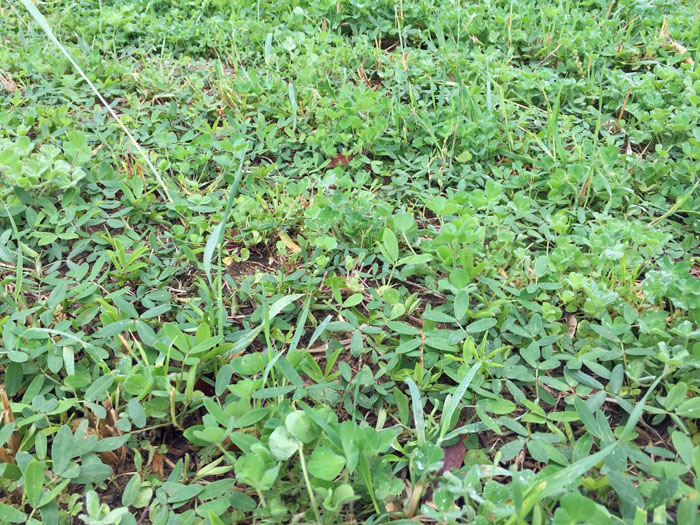
Spring is an important time of year to manage grazing of pastures. During the spring, warm-season perennials start to emerge from their cool-season dormancy. If you overseeded your pastures with cool-season forages, you need to manage the competition that happens during this transition period. Spring is also the prime season for growth of annual ryegrass and clovers. Solid, thick stands of clover and annual ryegrass (Figure 1 above) can actually injure warm-season perennial stands. It is a good practice to stock these overseeded pastures heavily and graze off the cool-season annuals by the end of March or early April to help reduce competition, as the warm-season perennials emerge. Once the cool-season forage is grazed off, the warm season forages can more rapidly emerge and be more competitive, until the the cool-season forages phase out.
Warm-season perennials do vary regarding spring growth. There are early (e.g. UF-Riata) and late (e.g. Argentine) varieties of bahiagrass and bermudagrass (eg. Jiggs earlier than Tifton-85). Early varieties will suffer more from competition during this transition period. These varieties start to regrow earlier in the spring, when the cool-season forages are still in their prime. The more the grass struggles the more root reserves will be depleted, leading to potential stand losses. Late varieties will start re-growing later, likely reducing this problem, however, there may still be a need to manage the grazing in order to minimize the competition. Increasing the grazing pressure during late March through early April will allow warm-season perennials to emerge and get off to a faster start. In Figure 2 below, you can see all of the forages: clovers, small grains, perennial peanut and bahiagrass that are all vying for nutrients and moisture at this time of year.

Another key aspect during the transition from cold to warm temperatures is the increase in soil nutrients, because of soil organic matter (SOM) mineralization. This is especially true in soils with greater organic matter. It is not a good practice to overgraze the warm-season perennials at any time, but particularly at the beginning of the grazing season. This is the time of the year when emerging grasses are using their stored reserves for new growth. If you overgraze during this time, those reserves could be depleted to the point of stand loss. You must allow time for the plant to produce new leaves and capture nutrients to promote more rapid growth. Do not lose the summer grazing season in the first month! Utilize lenient grazing pressure until it has formed enough leaf area to rebuild reserves. Plants need to intercept sunlight in order to grow and they can’t do that without leaves. After enough leaf area is formed, then you can increase the stocking rate and reap the benefits of good grazing management. Fertilization is always important in order to meet nutrient demand by plants, so a soil test should be performed in the winter. Spring fertilization will enhance plant growth so they reach the rapid plant growing phase earlier.
Take-Home Message
Grazing management during the spring-summer transition is key to persistence of warm-season perennials. Reducing competition from winter annuals as warm-season perennials are emerging will improve their persistence. Limited grazing pressure until warm-season perennials have produced adequate leaf area to restore reserves will boost productivity for the remainder of the season. Don’t weaken your pastures in the first month of grazing!
For more information on this topic, please see the following publication:
Grazing Management Concepts and Practices
 0
0
